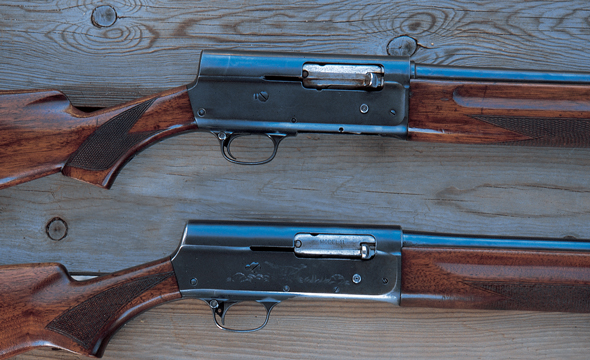Those Hammerin’ Humpbacks
Editor Dan Shideler | Jul 14, 2011 |From Gun Digest
It was a sad day in 1999 when Browning announced it was discontinuing the Auto-5 humpback. There wasn’t a dry eye in the house — at least not my house.My first experience with the Auto-5 came in 1996 at the hands of Lonnie Ray, my father-in-law. He had invited me to go duck hunting the day after Thanksgiving as soon as the turkey wore off. As dawn broke, I crouched in a duck blind on the edge of a flooded cornfield in Porter County, Ind. I hadn’t brought a gun with me during my holiday visit, so Lonnie lent me his Belgian Auto-5 Magnum.
I had seen many humpbacks through the years but had never fired one. When a lone drake mallard skittered over the paper-thin ice, I painted a stripe through him and touched ’er off. My life would never be the same.
Neither would my shoulder. As the duck crumpled, that old humpback slammed into me like an Erie-Lackawanna freighter on its 4:19 Toledo run. Beaming, Lonnie said, “That old Browning really hammers the ducks, doesn’t it?”
“Uh huh,” I gasped. “But how do you get them to shoot it?”
The Classic Design
Ah, the art and mystery of the Browning humpback. It’s been gone for six years, and every day and in every way, its square, uncompromising profile looks better. For 96 years, it remained in production — longer than any other model of shotgun. John Wayne used a humpback. So did John Dillinger. Its fame was such that even current Browning shotguns such as the Gold Classic High Grade are still described in company catalogs as “beautiful semi-humpbacks.” It was one of the greatest sporting firearms of all time.Introduced in 1903, the original Auto-5 was a marvel for its day. It embodied the first practical application of the long-recoil principle in a sporting firearm. Nowadays, the idea of a shotgun with a barrel that blows backward to eject the empty hull, cock the hammer and chamber a fresh shell seems laughably primitive. But in 1903, it was a daisy.
Not only was the Auto-5 the first successful autoloading shotgun, it was also the most flexible autoloader of its day. Today’s gas-operated rifles and shotguns gobble up anything you stuff in them, from light target loads to magnums. During the first few decades of the 20th century, however, that was different. In those days, autoloading pistols and rifles operated reliably only with one specific bullet weight and powder charge. Light loads wouldn’t cycle the action, and heavy loads would beat up the gun. The Auto-5 was different.
What made it different was the “friction ring.” This small, reversible ring of steel, beveled inwardly on one face, sits atop the recoil spring and encircles the magazine tube. With its beveled face pointing toward the magazine cap, the friction ring forces a springy collet called the “friction piece” to constrict around the magazine tube when the gun is fired, putting the brakes on the backward motion of the barrel during recoil. This is helpful if you are shooting heavy loads. With the friction ring reversed so its flat face points toward the magazine, the friction piece cannot constrict. That lets off the brakes and lets light loads cycle the action.
To switch from light loads to heavy loads or vice versa, you could remove the barrel, reverse the friction ring and replace the barrel. The problem arises when the friction ring is set in the wrong direction. Shooting a light load with the ring in the heavy-load position will typically produce a jam. Conversely, shooting a heavy load with the ring in the light-load position will typically belt the holy hell out of you, as I discovered in that Indiana duck blind. My teeth still hurt.
Many Other Features
In its day, the five-shot Auto-5 was all you needed for bobwhites to bears. Unlike its competitors, the Auto-5 incorporated a magazine cutoff, a small T-shaped lever protruding from the lower left side of the receiver. Flipping this lever let you feed one round directly into the chamber without having to unload the magazine. If you were pounding the cornfields for pheasants and kicked up an 8-point buck, you could flip the cutoff lever, open the action to eject your No. 6 load, slip in a slug, and say goodbye to Mr. Buck. At least that was the theory.The Auto-5 also introduced American shooters to the idea of an operating handle. For the benefit of those, including me, who incorrectly call it “that finger thing,” the operating handle is the small cocking piece you pull to charge a semiauto shotgun. Today, every semiauto has an operating handle. It seems like the most natural concept in the world, doesn’t it? However, the Auto-5 was the first sporting gun to feature an operating handle. Other semiautos of the day used plungers, toggle-joints and who knows what else as cocking pieces.
Foolproof reliability made the Auto-5 successful. Its natural-pointing characteristics made it beloved, though. Some shooters, such as my friend Jim Schlender, can pick up any shotgun and bust birds with it. Some of us, however, have a tough time finding shotguns that fit. For those so handicapped, an Auto-5 does what no other shotgun does: It points. That Gibraltar-like receiver rising before our eyes gives us a thrill no other shotgun can.
I am a good example. During a recent trap outing at the magnificent Iola, Wis., Conservation Club, I missed 10 straight with Jim’s Winchester 101, as fine a shotgun as I’m ever likely to hold. In frustration, I dug my 1939 Auto-5 out of my trunk. (I bought this grand old gun years ago in South Bend, Ind., home of the Fighting Irish, so I call it “the Humpback of Notre Dame.”) Sure enough, the birds began breaking — not all of them, but enough to make me smile.

No comments:
Post a Comment